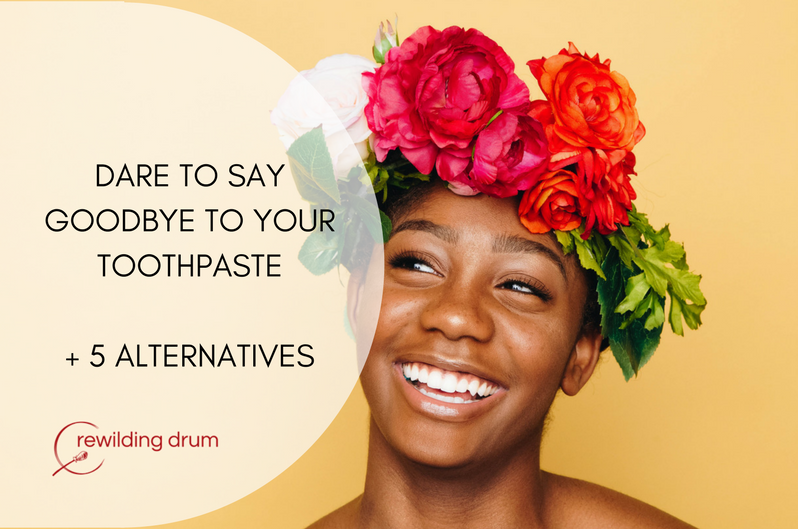When on the path towards self-sufficiency, almost all the products you consume can become an object of analysis: hygienic, cleansing, cosmetic, food, and clothing products … why do you purchase them?
If they are of no real necessity, then the goal is to stop using them completely. If, at the end, we decide with conscience that certain products do have importance in our life, then the goal is to manufacture them ourselves.
This is a good way to remove a lot of gear and “stuff,” break the chains of consumerism, and experiment with travelling light through life, like hunter-gatherers respecting the planet and ourselves. I do believe that if we want something to change on this planet, one of the best ways to do so is through responsible consumption, and the best way to get rid of the tyranny of consumerism is to stop relying on the harmful products that others invent to fill their pockets at the expense of our health. The task is not easy and the road is long, but this does not mean that we should just be waiting for the solutions to fall from the sky.
One of the products that we as a family really have been questioning over the years is toothpaste. Oral hygiene and dental health DO NOT depend on a brushing with toothpaste.
After a visit to the dentist, the only recommendation you receive is that to prevent the dreaded cavities, you should brush your teeth well using a paste rich in fluoride, and not abuse sugary products. I have not yet met any dentist who talks to you about correcting, for example, the food a patient eats.
Other ways to take care of your oral hygiene
We are more than accustomed to “solving” the problems based on industrial inventions and/or technology. In the case of oral hygiene, the solutions are usually products such as toothpaste, mouth rinses, and endless orthodontics.
Do dentists look for the cause of the problem? Rarely! They put a patch on the wound, but don’t cure the cause, because that would be a bad business model. Most of the time, the solution exists already, but not exactly in the form of an industrial product. This was demonstrated by the British doctors Sir Edward and Lady May Mellanby in the 1920s.
The Importance of Proper Nutrition
Beyond the harmful effect that massive consumption of sugar can have on the health on teeth, there are, however, many other key factors that hardly anyone considers.
A tooth is made up of three parts:
- the enamel (external part of the tooth)
- the dentine (the substance that forms the internal part of the tooth)
- the pulp (“living” tissues such as nerves and blood vessels)
Primary dentine is created during the formation of the tooth, but there is also a secondary dentine that occurs throughout life. One of its main characteristics is that it is not passive, but, in fact, capable of reacting in case of injuries from external aggressions.
Already in his time, May Mellanby verified the impact of feeding on the formation of this secondary dentine in dogs. He discovered that a diet rich in vitamin D, calcium and phosphorus produced abundant secondary dentine, regardless of the previous health of the tooth.
On the contrary, a diet low in vitamin D and rich in cereals gave rise to a weak and poorly calcified secondary dentine. This means that the teeth have a natural defense mechanism that allows them to respond to external attacks, but it is a mechanism that depends entirely on diet.
The couple continued their research, this time with children, reaching the same conclusion: it was possible to reduce cavities through a diet low in cereal and rich in vitamin D. A decade later, Dr. Weston Price and his wife conducted another very interesting study.
They travelled five continents in search of native populations who were relatively isolated from civilization to compare their teeth with those of nearby towns that had instead opted for a way of life typical of industrialized society.
They studied various dental problems, such as dental malocclusion and tooth decay. Their conclusion was overwhelming: the children of parents who had opted for an industrial diet (flours, oils, and refined sugar) suffered serious dental deterioration that was practically non-existent in the populations that had maintained their traditional diet.
Another example is the traditional food of the Inuit people, rich in vitamin C (whale skin), vitamin D (seal oil), and omega-3 fatty acids. There were practically no dental problems in those who maintained this way of eating instead of consuming industrialized food.
The very interesting work of Weston A. Price is well documented in his book, Nutrition and Physical Degeneration.
The Army of Bacteria
From the mouth to the intestine, an army of different types of bacteria populate the path that food runs through the body. Although bacteria might seem unhealthy, they are essential for health in general and for dental health in particular.
In 2013, the magazine Nature Genetics revealed two important historical moments of transformations in the composition of this army of bacteria:
- About 10,000 years ago, during the Neolithic period, when we started to grow cereals.
- During the Industrial Revolution, around 1850, when we started to consume refined flour and sugars.
The study analyses 34 European skeletons and shows that the adoption of agriculture resulted in a bacterial configuration that favored dental problems.
Because of the Industrial Era, cariogenic bacteria began to proliferate in the gut. Today our oral microbiota is much less diversified than that of our hunter-gatherer ancestors. The same goes for the intestinal flora. At present, we know that the more diversity in its composition, the better the health of an individual.
The same thing happens in the mouth. Any disturbance that it suffers leads to the proliferation of pathogenic bacteria that reduce our health. This is one of the reasons why it is not so advisable to walk around all day brushing your teeth and disinfecting your mouth with all kinds of products that threaten the bacterial balance. A healthy mouth is not necessarily that of the Hollywood smile, but rather a mouth full of healthy bacteria that form a very precise ecosystem which acts in perfect synergy with digestion.
What Foods Should I Avoid?
To maintain this balance, it is necessary to avoid eating foods that put you in danger:
- An excess of poor-quality sugars or carbohydrates
Carbohydrates are the only group of macronutrients whose digestion begins in the mouth by the action of the enzyme amylase. The process results in the production of simple sugars that are, in turn, food for bacteria, and acid, which destroys the enamel and ends up causing cavities.
- Soft drinks
These contain lots of sugar, with the dangers that we have just explained, as well as other acids that destroy the enamel.
- Citrus juices
These are also excessively acidic, so the risk of damaging the enamel is high. One option is to drink them with a straw (glass or biodegradable) or not to brush your teeth immediately after ingesting them so as not to increase the abrasion of the enamel.
What Foods Should I Eat?
We should prioritise foods rich in fat-soluble vitamins such as A, D and K2. Why? Because one of the main functions of these vitamins is the correct absorption of minerals into our body. Both vitamin D and K2 favour mineralization of the teeth. Mineralization of the teeth is a process in which calcium and phosphate ions are sourced to promote ion Recommended foods include:
- Vitamin A is found in products such as egg yolk, butter or liver.
- Vitamin D can be found in fatty fish, eggs or butter and from sunbathing.
- Vitamin K2 is produced naturally in a healthy intestine by bacteria in the colon. It is also present in some foods such as butter, egg yolk, cured cheeses, and fatty fish.
Alternatives to Toothpaste
The toothpastes that we find in most of the stores have a good amount of additives that are less useful than one should want or expect. The most controversial is fluoride.
One of the promoters of its supposed benefits, a doctor in biochemistry named Hardy Limeback, was the former head of the Department of Preventive Dentistry at the University of Toronto. He ended up publicly apologizing in 1998, stating, “We have overwhelming evidence confirming that the fluorine is more harmful than beneficial to health. Children under three should not drink fluoridated water or consume toothpastes containing this heavy metal.” Based on various studies, he concluded that fluoride weakens bones and teeth and alters intellectual performance even in small doses.
Do You Dare to Try Alternatives?
There are many simple alternatives that are more effective in addressing oral health.
I present to you the ones that we have tried so far, as they have given us good results. The idea is to alternate them all instead of staying with only one option, since each one acts in a different way and contributes to a certain benefit.
#1. Salt Water
Unrefined sea salt re-mineralizes teeth and helps to rebalance the oral pH.
- Dilute ¼ of a tablespoon of salt in a glass of warm water.
- Soak the toothbrush in it and brush your teeth with this solution.
- For a fresher breath, add a couple of drops of essential oil (lemon, tea tree, mint) into the salt jar (not in the water with the salt dissolved).
Never use salt directly on the teeth because it is abrasive for the enamel!!
#2. Coconut Oil
Coconut oil is an antifungal and antibiotic. Just use a little bit on the toothbrush, and you’re all set!
You can also try the ayurvedic practice known as oil pulling. It consists of rinsing your mouth in the morning before ingesting anything with a spoonful of oil (you can use any oil you have on hand, but for me, coconut has the most pleasant taste for rinsing).
You have to swish with it for about 20 minutes (while doing other things 🙂 until it acquires a milky consistency as it is mixes with saliva and adheres to bacteria and toxins in the mouth. at the end of 20 minutes, spit it out (never swallow it, as it is full of toxins) and rinse your mouth out with warm water.
#3. Ash
In India, teeth are bleached with a little ash. When you are in the middle of nature, ash is a good resource that is as valuable as deodorant, but be careful!
- The ash is very active, but it also dries the mucous membranes and damages the enamel if it is used too often. It is better to use it only once in a while.
- You must use only natural wood ash, never ash that is painted or treated.
#4. Clay with Pulverized Plants
In a glass jar, mix a spoonful of extra-fine white clay with a tablespoon of dried powdered plants. Add three drops of essential oil to taste (lemon, tea tree, or mint).
You can use the following plants (I like to use a mixture of several). Keep trying until you get the mix that you like best:
- horsetail, rich in silicon
- mint
- stevia and/or licorice root to sweeten naturally
- thyme
- fennel seeds
- cinnamon
- a couple of cloves
To grind up the plants, you can use a coffee grinder, and then pass them through a sieve, and then, discard the pieces that do not pass. Keep the mixture in a glass or ceramic container.
The simplest way to use this type of “toothpaste” is to take small amounts with the same brush slightly moistened in water, or put a little on the brush with a wooden or ceramic spoon (never metal).
#5. Dental Sticks
Using toothpicks is another good practice for oral hygiene. The ideal is to make them yourself. In our case, we have two huge goji berry plants in the garden. Apart from the delicious fruit, we also use its long thorns for this purpose.
Another type of plant with thorns that can help you to have your own chopsticks without going to the store is hawthorn, or any other that has long enough thorns.
The Horrors of Plastic Brushes
In addition to being bad for the environment, conventional brushes wear out very quickly, because the plant-based toothpaste sticks on the brushes and completely cleaning the brush becomes complicated.
For both reasons, we recommend natural toothbrushes, such as those made of ecological bamboo, which, in principle, are more resistant to dental products. In our case, when they are worn out, we burn them in the bonfire, and the cycle is closed without leaving no trace in your body or on the planet.
Now It’s Your Turn
- What do you think of the practices we have just proposed?
- Do you still use brushes and conventional toothpastes?
- Do you want to share your oral hygiene tricks with us?
We wait for your comments!
Thank you very much for being there … a big hug!
Pictures Credits:
- Autumn Goodman for Unsplash, Black Girl with Flowers
- Kevin Walsh









Hallo Bert en Kiki,
Fijn om nog meer achtergrondinformatie te krijgen over het hoe en waarom van weglaten van conventionele tandpasta.
Al ruim een jaar poets ik mijn tanden met kokosolie vermengd met wat zout en etherische olie. Mijn tanden zijn schoner dan voorheen, mijn tandarts heeft weinig te doen als ik op controle kom, geen tandplak, geen gaatjes. Ik ben heel tevreden over de overstap op kokosolie als tandpasta in combinatie met tandenstokers!
Jammer dat er aan veel tandenstokers ook fluoride is toegevoegd.
Fijn om te lezen dat er nog meer mogelijkheden zijn om mijn mond op een natuurlijke wijze te verzorgen.
Dank voor je antwoord Linda, Goed bezig zouden we zeggen 🙂
Vr gr
Bert
Hi Kiki & Bert!
My dental hygiene:
-brush with a bamboo brush (they also come with animal hair bristles instead of nylon)and I still use my electric one (ooops)
-tooth powder based on bicarbonate
-tooth soap based on coconut and olive oil
-miswak stick, a root that when wet becomes a bristle. Birch twigs apparently are effective as well.
Next step: decreasing my carbon foot print and making the products myself/ get it from local (small) businesses.
By the way, since eating low carb and leaving out bread and pasta, I have much less plaque and tartar.
Always good to hear from you, keep up the good work.
See you soon!
Great article, I herd a while back to use soap when cleaning your teeth.
Thanks for your comment Carl, We love your work !
Oké, ik ga dat proberen.
Kokosolie en zout…
Hou ons op de hoogte !